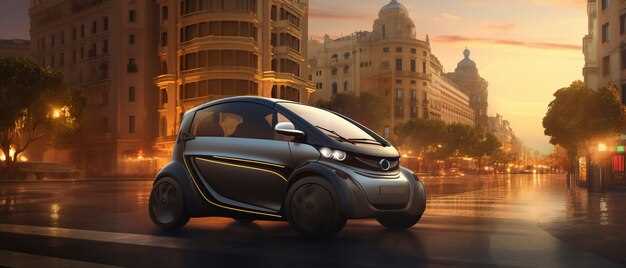Adopting solid-state batteries can significantly enhance electric supercars’ performance. These batteries offer higher energy density, shorter charging times, and improved safety compared to traditional lithium-ion batteries. By integrating solid-state technology, manufacturers can not only increase driving ranges but also reduce the weight of the vehicles, leading to better handling and acceleration.
Investing in advanced aerodynamics will reshape the design of electric supercars. Automated spoilers and active air intakes will optimize airflow, enhancing speed and stability. This technology allows engineers to tune the vehicles dynamically based on speed and driving conditions, effectively improving both efficiency and performance.
Keep an eye on regenerative braking systems. These systems not only provide energy recovery but also enhance driving control, providing a smoother experience. With continuous refinements, this technology is becoming more efficient, enabling drivers to extend their range and enjoy better handling on the track.
Artificial intelligence plays an increasingly pivotal role in the performance of electric supercars. Real-time data analysis helps in optimizing driving patterns, while machine learning algorithms enhance the vehicle’s responsiveness to driver inputs. As these systems mature, expect to see supercars that adapt autonomously to various driving conditions, ultimately elevating the driving experience.
Lastly, consider the integration of connected features. Electric supercars are poised to embrace vehicle-to-everything (V2X) communication, allowing them to interact with other vehicles and infrastructure. This synergy will promote safer driving environments and more efficient traffic management, showcasing a futuristic approach to mobility.
Advancements in Battery Technology for Supercars
Consider ultrafast charging capabilities as a primary focus for future supercars. Solid-state batteries are emerging as a frontrunner, offering higher energy density and significantly reduced charging times compared to traditional lithium-ion batteries. These batteries utilize a solid electrolyte, which enhances safety and performance metrics, enabling supercars to achieve longer ranges with less downtime.
Investigate the development of lithium-sulfur (Li-S) batteries. These batteries promise up to five times the energy density of conventional lithium-ion variants. With advancements in nanotechnology, manufacturers are effectively addressing issues like short cycle life and low conductivity. Li-S batteries could become a game-changer for supercar performance, allowing manufacturers to reduce weight and increase speed without sacrificing range.
Explore battery thermal management systems that optimize performance under extreme conditions. Efficient cooling solutions prevent overheating and support consistent performance during high-speed runs. Innovations such as phase-change materials and advanced cooling liquids are key to maintaining battery integrity in demanding environments.
Integrate vehicle-to-grid (V2G) technology, allowing supercars to interact with the power grid. This feature not only promotes energy efficiency but also creates new revenue streams for owners by selling back excess stored energy. With this capability, supercar owners could contribute to grid stability while maximizing their investments.
Monitor developments in recycling and sustainability practices. As battery demand increases, the focus on eco-friendly manufacturing and end-of-life recycling will grow. Innovations in recycling processes can reclaim up to 95% of battery components, significantly reducing environmental impact.
Follow advancements in supercapacitors as complementary energy storage solutions. These devices charge and discharge rapidly, enhancing acceleration and regenerative braking capabilities. Combining supercapacitors with traditional batteries could optimize energy delivery for high-performance applications, providing supercars with a competitive edge.
Integration of Autonomous Driving Systems in Electric Supercars
Incorporate advanced sensor technologies, such as LIDAR and radar, to enhance the perception capabilities of electric supercars. These systems enable vehicles to detect obstacles, pedestrians, and road conditions with high precision, crucial for safe autonomous driving.
Utilize robust machine learning algorithms to improve decision-making processes. Implementing AI systems allows electric supercars to learn from real-time data and adapt to various driving scenarios. This leads to more intuitive and responsive vehicle behavior, especially in dynamic environments.
Focus on seamless software integration among vehicle components. A well-designed architecture enhances communication between sensors, control units, and user interfaces, resulting in smoother operation and a more satisfying driving experience.
Invest in high-performance computing systems that can process vast amounts of data quickly. This capability is necessary for real-time analysis and response during autonomous operation, ensuring that vehicles react effectively to changing conditions.
Encourage collaboration with tech companies specializing in autonomous systems. Partnering with experts in fields like AI, robotics, and data analytics can boost innovation and accelerate the development of cutting-edge features in electric supercars.
Implement extensive testing and validation protocols. Simulated environments complement real-world testing, allowing manufacturers to rigorously assess system performance under diverse conditions to enhance safety and reliability.
Design user-friendly interfaces that provide drivers with clear information about the vehicle’s autonomous capabilities. Transparency in operation builds trust and helps users feel confident in the technology.
Prepare for regulatory compliance by understanding local laws surrounding autonomous driving. A proactive approach ensures that electric supercars meet all legal standards, paving the way for smoother market introduction.
Impact of Lightweight Materials on Performance and Range
Utilizing lightweight materials such as carbon fiber, aluminum alloys, and advanced composites significantly enhances electric supercars’ performance and driving range. By reducing overall weight, manufacturers can achieve higher acceleration and improved handling, translating into a more thrilling driving experience.
Carbon fiber, for example, is a popular choice due to its high strength-to-weight ratio. Many supercars incorporate carbon fiber in their chassis and body panels, cutting down weight by 40% compared to traditional steel structures. This not only accelerates the vehicle but also boosts energy efficiency, extending range.
Aluminum alloys contribute to lower weight while maintaining structural integrity. Modern electric supercars often use aluminum for subframes and suspension components. By replacing heavier materials, manufacturers can reduce unsprung weight, enhancing ride quality and responsiveness.
The table below illustrates the weight reduction potential offered by various lightweight materials:
| Material | Weight Reduction (%) | Benefits |
|---|---|---|
| Carbon Fiber | 30-50 | High strength, corrosion resistance |
| Aluminum Alloys | 20-40 | Durability, recyclability |
| Magnesium Alloys | 10-30 | Lightweight, good fatigue resistance |
| Advanced Composites | 15-35 | Customizability, impact resistance |
By integrating these materials, electric supercars can optimize performance metrics such as top speed and lap times. Additionally, lighter weight translates to decreased energy consumption, allowing for longer travel distances on a single charge. Manufacturers focusing on lightweight engineering unlock new potentials in electric vehicle technology, appealing to performance enthusiasts and eco-conscious consumers alike.
In summary, the transition to lightweight materials marks a significant advancement in electric supercar design, driving both performance improvements and expanded range. The focus on innovative materials aligns perfectly with the future of high-performance electric vehicles. Harnessing this technology paves the way for exciting innovations yet to come.
Innovations in Electric Drive Systems for Enhanced Power Delivery
Utilizing multi-motor configurations significantly increases traction and power management in electric supercars. By placing individual motors at each wheel, manufacturers can achieve optimal torque vectoring, enhancing cornering stability and acceleration.
Incorporating silicon carbide (SiC) technology improves the efficiency of power electronics. SiC transistors enable faster switching speeds and reduce energy losses, contributing to better overall performance. This advancement allows supercars to maintain high power outputs while minimizing heat generation.
Advanced battery management systems (BMS) focus on real-time monitoring and optimization of battery performance. Smart algorithms adjust energy distribution based on driving conditions, ensuring maximum output during acceleration and efficient energy recovery during braking.
Integration of regenerative braking systems captures kinetic energy during deceleration, converting it back into electrical energy for battery recharge. Enhanced algorithms fine-tune this process, ensuring a smooth and efficient transition between braking and acceleration.
Looking to the future, wireless charging technology presents exciting possibilities. Developing ultra-fast charging pads allows for quick energy replenishment without physical connectors, making the refueling process more convenient and accessible at various locations.
Applying artificial intelligence in drive systems enhances decision-making during dynamic driving situations. By analyzing data from vehicle sensors and road conditions, AI can optimize power distribution and improve handling characteristics in real-time.
Role of AI in Optimizing Driving Experience and Vehicle Dynamics
Integrate AI algorithms to enhance driving performance through real-time data analysis. These systems assess road conditions, weather patterns, and driving behaviors, adjusting vehicle dynamics accordingly.
Utilize AI-powered adaptive suspension systems. They continuously monitor the terrain and modify stiffness levels, ensuring a smoother ride while maintaining optimal handling. This leads to improved stability during high-speed maneuvers.
Adopt machine learning for predictive analytics. By learning from driver habits, the AI can customize settings like throttle response, steering sensitivity, and braking force. This personalization elevates the driving experience, making each ride unique and tailored.
- Dynamic Torque Distribution: Implement AI to analyze traction and distribute torque between wheels in real-time, enhancing grip and control.
- Collision Avoidance: Use AI algorithms to detect potential obstacles and calculate optimal avoidance maneuvers, significantly increasing safety.
- Energy Management: Apply AI for intelligent battery management, optimizing energy use during acceleration and braking, extending vehicle range.
Incorporate AI into infotainment systems to provide intuitive interfaces. Voice-command features and personalized recommendations make navigation and music selection seamless, allowing drivers to focus on the road.
Continuous feedback loops play a critical role. AI systems can gather insights from various sensors and cameras, adjusting driving dynamics based on performance metrics and environmental changes, leading to improved overall efficiency.
Employ AI for diagnostic purposes. Detecting issues before they escalate ensures optimal vehicle operation and enhances the longevity of the supercar.
Lastly, foster connectivity between vehicles. AI can facilitate communication among cars to anticipate and respond to traffic patterns, collectively optimizing flow and reducing congestion on the road. This interconnectedness promotes safer and more enjoyable driving experiences for all.
Charging Infrastructure Developments for High-Performance Electric Vehicles
To support high-performance electric vehicles (EVs), charging infrastructure must advance in both speed and accessibility. Install fast-charging stations that provide at least 350 kW of power, allowing drivers to recharge a significant portion of the battery in under 15 minutes. Companies like ChargePoint and Electrify America are expanding their ultra-fast charging networks, enabling seamless long-distance travel for supercar enthusiasts.
Consider integrating charging stations at strategic locations such as highway rest stops, high-end dealerships, and exclusive destinations. Collaboration with local governments and private entities can lead to deploying more charging points in urban centers and areas of high foot traffic, enhancing convenience for supercar owners.
Adopt battery-swapping technology as an alternative to traditional charging. This innovation allows drivers to exchange depleted batteries for fully charged ones in just minutes. Companies like NIO are pioneering this approach, making it viable for supercars that demand rapid energy replenishment.
Incorporate smart grid technologies to optimize energy use during peak hours. Implementing dynamic pricing models encourages charging during off-peak times, lowering costs for users while maintaining grid stability. Integrate renewable energy sources into charging stations, enhancing their sustainability and reducing reliance on fossil fuels.
Enhance user experience with mobile apps that provide real-time information about charging station locations, availability, and pricing. Features like reservation systems and payment integration streamline the charging process, making it more efficient for supercar owners.
Invest in wireless charging solutions, allowing drivers to charge their vehicles without physical connections. This technology can be particularly advantageous for urban environments, where space is limited and convenience is paramount.
Promoting public awareness about the benefits of high-performance EVs and charging infrastructure can drive adoption. Organize events showcasing the capabilities of supercars and highlight advancements in charging technologies, fostering a community of enthusiasts who advocate for further development.







